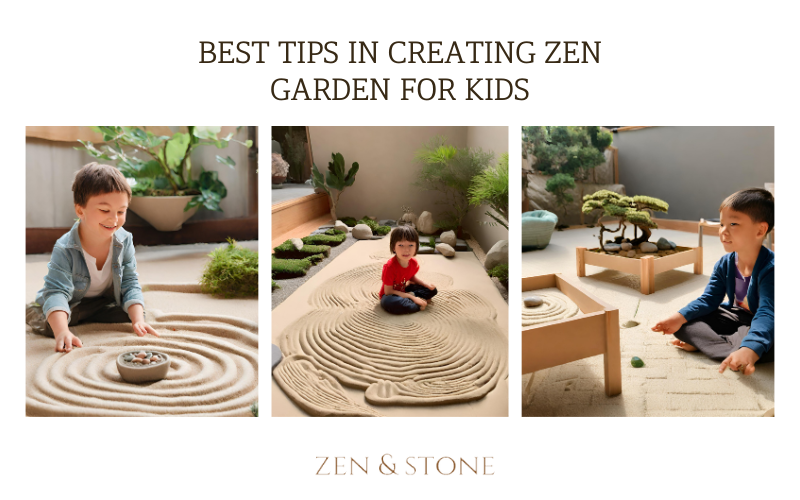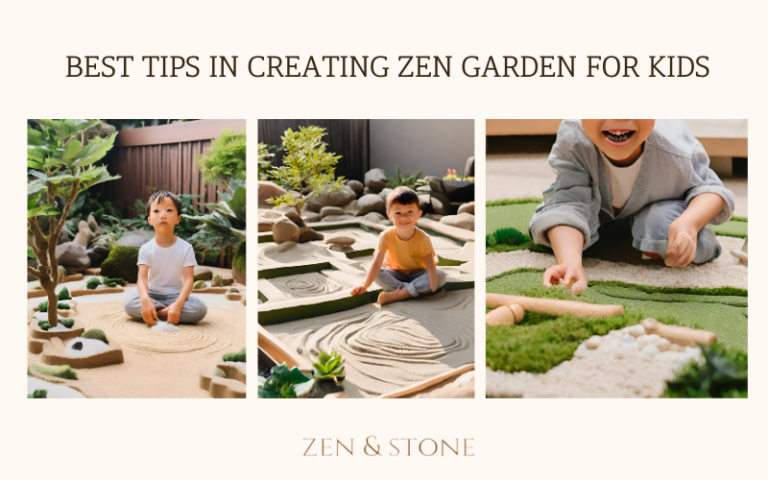
15 Oct Best Tips in Creating Zen Garden for Kids
Zen gardens are not just for adults. They can also be a great tool for promoting relaxation and mindfulness in children. Zen gardens, also known as Japanese rock gardens or karesansui, are miniature landscapes made of sand, rocks, and other natural elements that can be raked and arranged to create patterns and designs.
Using a zen garden with kids can be a fun and engaging activity that promotes a sense of peace and meditative contemplation while instilling respect, care of the environment, and cultural awareness. Children can experiment with creating different patterns and designs in the sand, which can help improve their focus and concentration. Additionally, using a zen garden can help children learn to manage their emotions and reduce stress and anxiety.
Key Takeaways
- Zen gardens can be a great tool for promoting relaxation and mindfulness in children.
- Using a zen garden can help improve children’s focus and concentration while reducing stress and anxiety.
- When choosing a zen garden for kids, it’s important to consider size, materials, and accessories that are safe and appropriate for children.
Understanding Zen Gardens
Origins and Purpose
Zen gardens, also known as Japanese rock gardens or karesansui, have been a part of Japanese culture for centuries. They were originally created by Zen Buddhist monks as a way to meditate and contemplate the beauty of nature. Zen gardens typically consist of sand or gravel, rocks, and sometimes plants arranged in a way that represents a miniature landscape.
The purpose of a zen garden is to create a peaceful and meditative environment. The act of raking the sand or gravel is meant to be a calming and meditative activity. The rocks and plants are arranged in a way that represents mountains, islands, and other natural features, creating a sense of tranquility and harmony.
Benefits for Kids
Zen gardens can be a great tool for helping kids develop mindfulness and relaxation skills. By focusing on the act of raking the sand or arranging the rocks, kids can learn to quiet their minds and be present in the moment. This can help reduce stress and anxiety and improve overall well-being.
In addition to promoting relaxation, zen gardens can also help kids develop creativity and problem-solving skills. By experimenting with different arrangements of rocks and plants, kids can learn to think creatively and come up with unique designs. They can also practice problem-solving by figuring out how to create a balanced and harmonious landscape.
How to Use a Zen Garden with Kids
A Zen garden is a perfect tool for children to learn mindfulness and relaxation while also developing their creativity and imagination. Here is a step-by-step guide on how to use a Zen garden with kids and some activities to incorporate learning.
Step by Step Guide
- Set up the Zen garden: Start by choosing a suitable container and filling it with sand. You can use a tray with steep sides and handles to allow your child to work with their garden at any time. Make sure to choose sand that is fine and smooth, such as play sand or decorative sand.
- Add accessories: Choose accessories to decorate the Zen garden such as rocks, crystals, driftwood, or other natural objects. You can also add small figurines or toys to make the garden more playful.
- Rake the sand: Use a small rake or a stick to create patterns in the sand. Encourage your child to experiment with different designs and movements. Raking the sand can be a calming and meditative activity.
- Mindful breathing: Incorporate mindfulness into the activity by practicing breathing exercises. Encourage your child to take deep breaths and focus on the sensation of the air entering and leaving their body while raking the sand.
Incorporating Learning Activities
- Geography: Use the Zen garden as a tool to teach your child about geography. Add miniature landmarks or flags to the garden and encourage your child to learn about different countries and cultures.
- Art: Encourage your child to create their own Zen garden designs using different colors and textures of sand. They can also use the garden as a canvas to create miniature sculptures or paintings.
- Science: Teach your child about the properties of sand and how it behaves when raked or moved. You can also add magnets or other materials to the garden to explore the concept of magnetism.
Using a Zen garden with kids is a fun and educational activity that can help them develop mindfulness, creativity, and curiosity. With these simple steps and activities, you can create a peaceful and inspiring space for your child to explore and learn.
Choosing the Best Zen Garden for Kids

When it comes to selecting the best Zen garden for kids, there are a few factors to consider. Here are some things to keep in mind:
Material Considerations
Zen gardens can be made from a variety of materials, including wood, plastic, and metal. Wooden Zen gardens are often the most popular choice, as they are durable and natural-looking. Plastic Zen gardens are lightweight and easy to clean, while metal Zen gardens can be more expensive but are also very durable.
Size and Design
The size and design of the Zen garden is also an important consideration. Small Zen gardens are perfect for kids, as they are easy to manage and don’t take up too much space. Look for Zen gardens that are designed with kids in mind, with bright colors and fun shapes. Some Zen gardens even come with toys or figurines that can be used to create different scenes.
Recommended Brands
There are a number of brands that make Zen gardens for kids. Here are a few recommended options:
- The Indigo Teacher: This brand offers a wooden sand tray that comes with fine white sand, two types of bamboo rakes, small stones, and a booklet of zen meditations.
- Kids Relaxation: This brand offers a DIY Zen garden kit that includes sand, rocks, and a small origami or toy bird.
- Projects with Kids: This brand offers a variety of DIY Zen garden kits that can be customized with rocks, crystals, and driftwood.
Reviewed: This brand offers a pre-made Zen garden that includes trees, stones, and a reflection bridge.
Maintaining a Zen Garden
Routine Care
Maintaining a Zen garden is relatively easy, but it does require some routine care to keep it looking beautiful and peaceful. Here are some tips to help keep your Zen garden in top condition:
- Rake the sand regularly to ensure that it remains smooth and level. This will help to create a calming and meditative environment.
- Remove any debris, such as leaves or twigs, from the garden to keep it looking neat and tidy.
- Water any plants that are growing in the garden, but be careful not to overwater them. Zen gardens are designed to be dry landscapes, so you don’t want to create a muddy mess.
- If you notice any weeds growing in the garden, remove them promptly to prevent them from taking over.
Safety Measures
While Zen gardens are generally safe for kids to use, there are a few safety measures that parents should keep in mind:
- Make sure that any rocks or other objects in the garden are not sharp or dangerous. If necessary, replace them with smoother or safer objects.
- Keep the garden away from any sources of heat, such as candles or fireplaces, to prevent a fire hazard.
- If you are using a tabletop Zen garden, make sure that it is placed on a stable and level surface to prevent it from tipping over.
By following these simple tips, you can help to ensure that your Zen garden remains a peaceful and calming space for your child to enjoy.
Conclusion
Zen gardens are a great way to introduce kids to mindfulness and relaxation. They provide a calming and peaceful environment that can help kids unwind and reduce stress. Creating a zen garden can also be a fun and engaging activity for kids that promotes creativity and imagination.
When selecting a zen garden for kids, it’s important to consider the size and materials. A shallow container or tray filled with fine sand or kinetic sand is ideal for small hands. Kids can use a wooden or plastic fork to create designs in the sand and add rocks, crystals, or other small items to personalize their garden.
Parents and caregivers can also use zen gardens as a tool to teach kids mindfulness techniques. Encouraging kids to focus on their breath while making designs in the sand can help them develop a sense of calm and relaxation. Additionally, using positive affirmations while breathing can help kids develop a more positive mindset.
Sorry, the comment form is closed at this time.